Closed-loop disturbance signal estimation
What is it?
The disturbance is an additive signal that moves the output of the given unit process. Counter-acting disturbances are the very reason that feedback controllers are used, they observe the deviation between setpoint and measurement of the plant output, and change one-or more inputs to counter-act the disturbance.
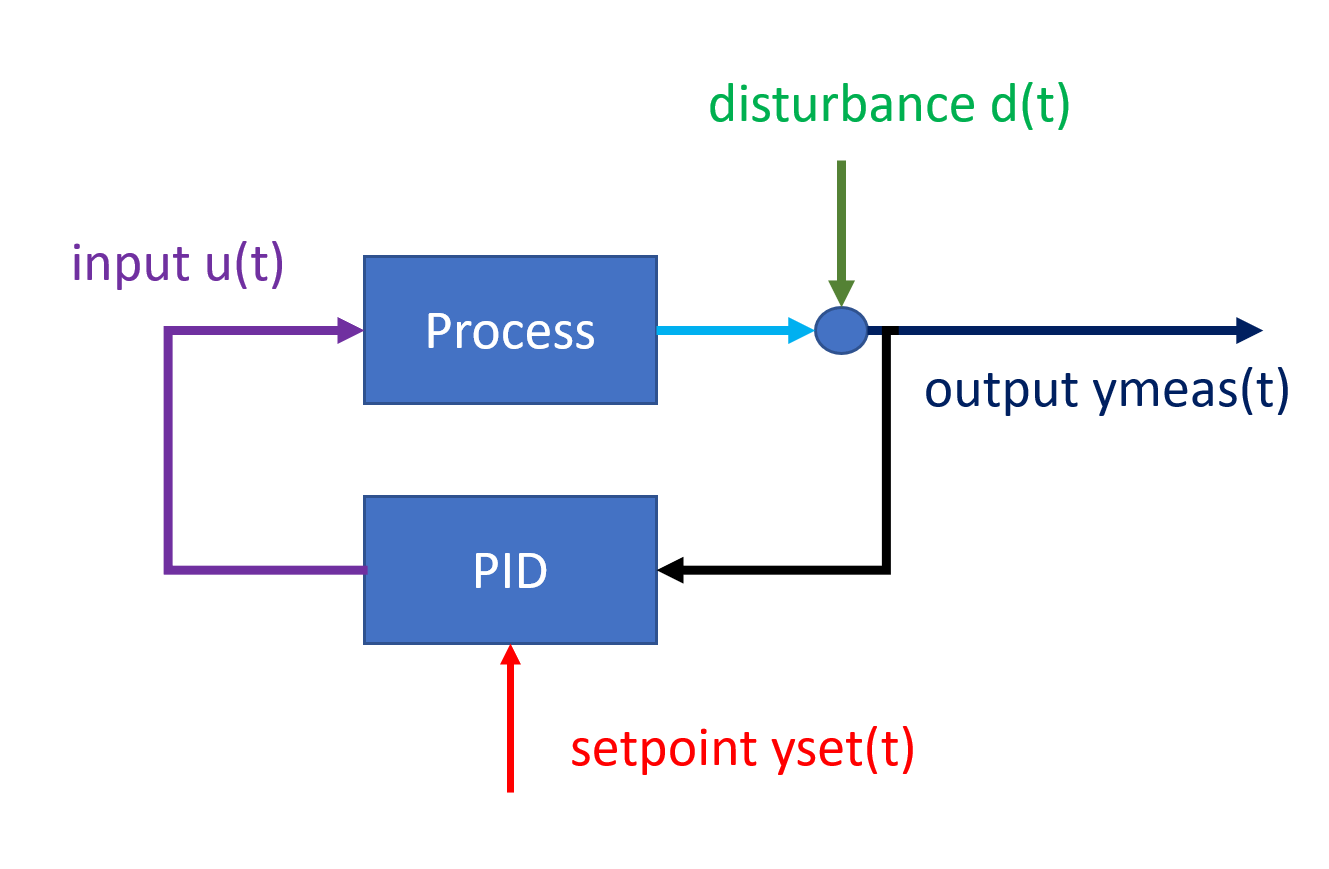
Example: step disturbance
Consider a step disturbance acting on a system without feedback
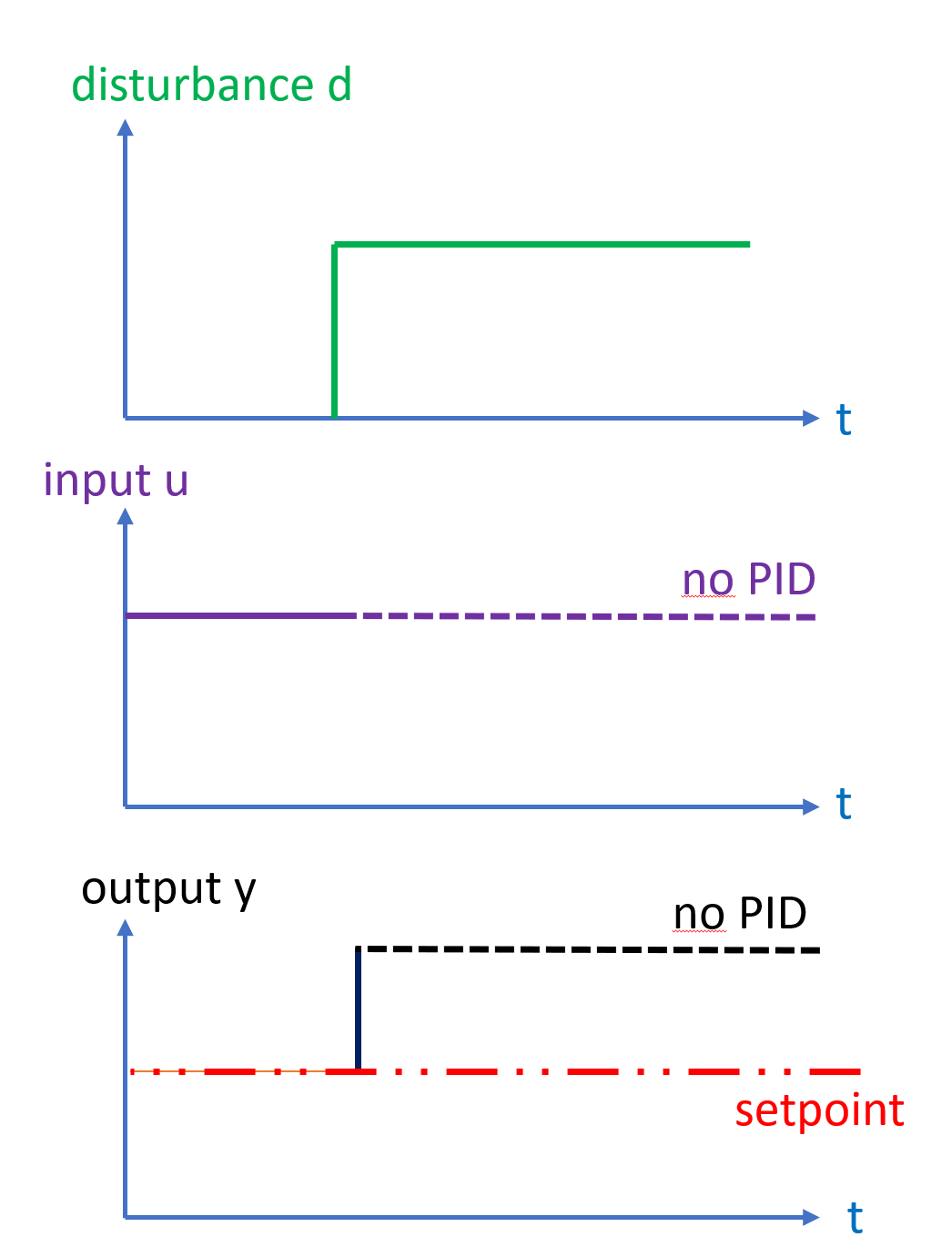
The feedback is directly fed through to the output, while the input is constant.
Now consider and compare the same step disturbance, but this time a PID-controller counter-acts the disturbance
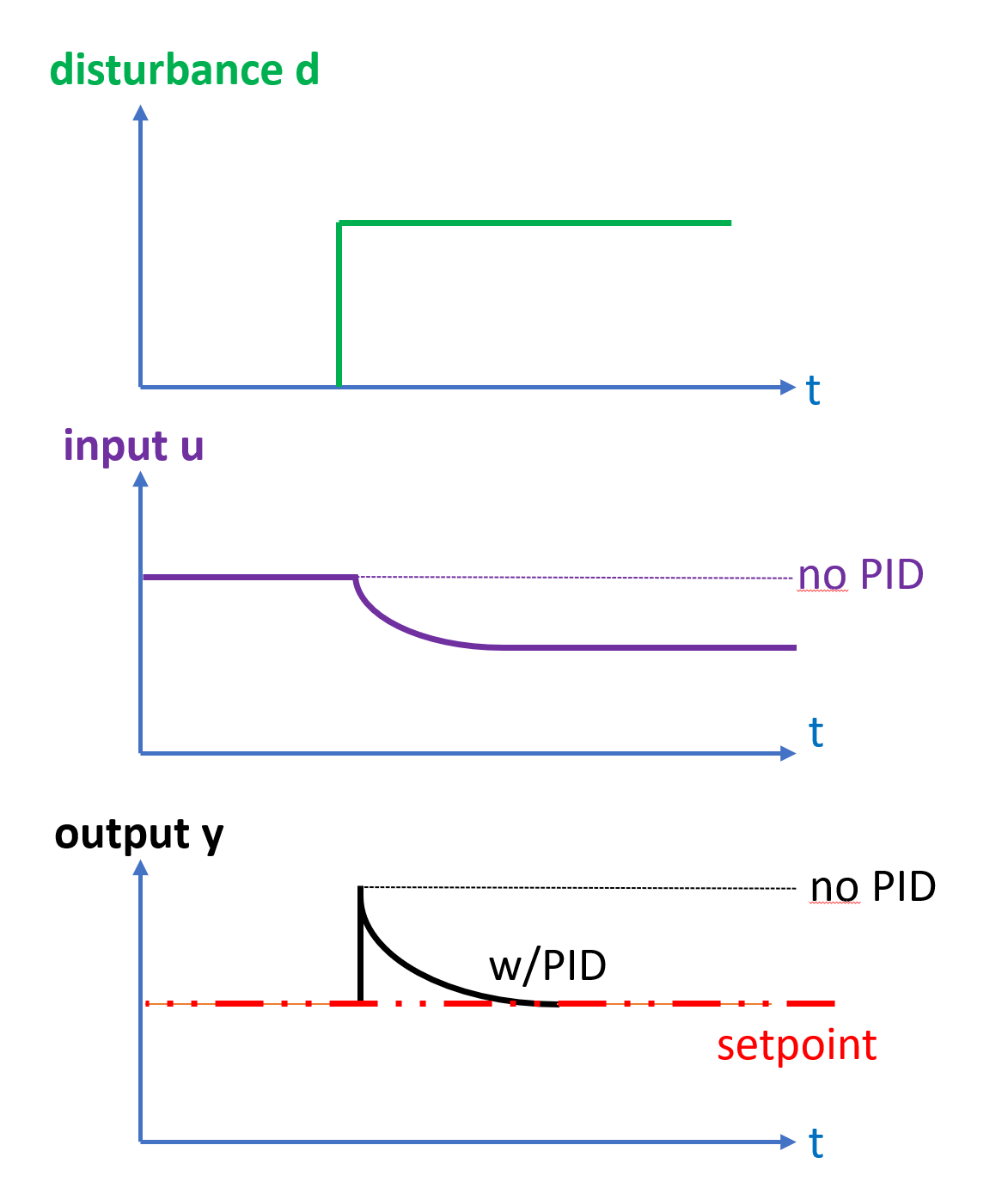
The disturbance initally appears on the system output, then is slowly counter-acted by change of the manipulated
variable u by feedback control, thus moving the effect of the disturbance from the output y to the
manipulated u.
Observing the offset between setpoint and measurement gives a "high-frequency" d_HF response and is seen
first, while the change in u is gradual and "low-frequency" d_LF and the approach
will attempt to combine the two as shown below
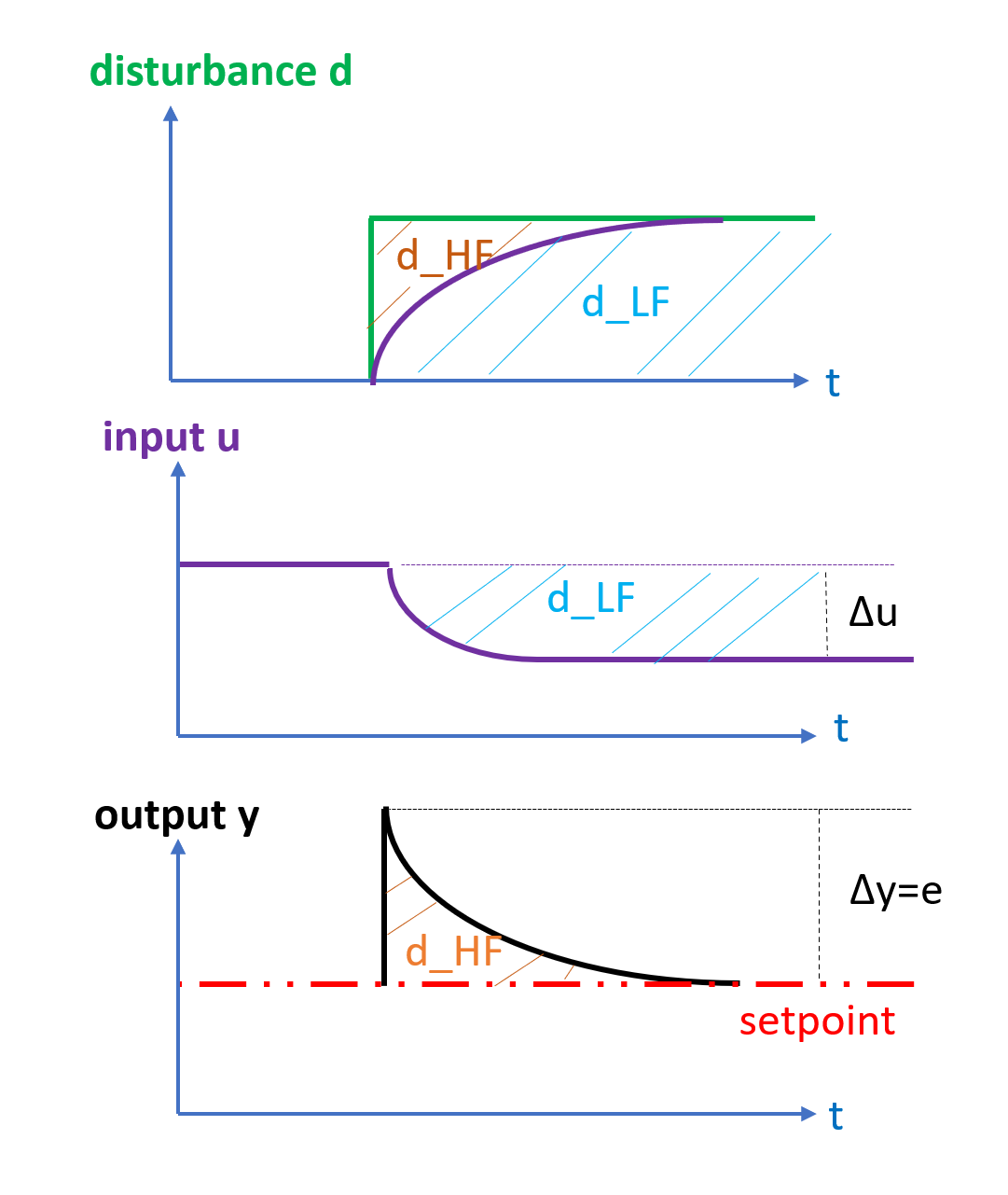
The aim of this section is to develop an algorithm to estimate the the un-measured disturbance d
indirectly based on the measured u and e
Why is distrubance signal estimation important?
Disturbances are the "action" or "excitation" that causes feedback-controlled systems to move, if these signals could be estimated, then a disturbance could be "played back" in a simulation and different changes to the control system could be assessed and compared.
Describing the disturbance signal is also important for identifying the other components of a feedback-controlled system correctly, as disturbances are "non-white" noise that tends to skew estimates (destroying the regression accuracy) if not accounted for.
What are the challenges?
The challenge in describing disturbances in feedback-systems is that the feedback aims to counter-act the very disturbance which needs to be described by changing the manipulated variable.
Thus, the effect of the disturbance is in the short-term seen on the system output y,
but in the long-term the effects of the disturbance are seen on the feedback-manipulated variable
u. The PID-controller will act with some time-constant on u,and this change in u
will again act back on the output y with a delay or dynamic behavior that is
given by the process(described by the process model.) To know what amplitude a disturbance has,
requires knowledge of how much effect (or "gain") the change in manipulated variable u will
have caused on the output y.
The measurement y_measshows us the combination of the disturbance d and the process output y_process
y_meas[k] = y_proc(u[k-1]) +d[k] =
Note the above convention for y_proc, d and y_meas are consistent with the convention used by PlantSimulator. This is important, as the PlantSimulator is used in the estimtion of disturbances.
In most cases only a single u(t) is considered, and this is the pid-output u=u_pid(k).
Note
in general it is hard to know if the observed closed-loop behavior y_meas,u_pid
is due to a process with large process gain and the u_pid responding to large disturbances
or if the pid-controller is reacting to small disturbances for a process with small gains.
Observations
- Note that
y_processis not directly observable unless the disturbance is zero. - y_process depends on one or more inputs u(t) that are measured.
- one of the inputs to the
y_processis the output of the pid-controller, which looks aty_measand tries to counter-act disturbances that enter, thusy_processandd(t)will be covariant.
Note
If the process model were known in a closed feedback loop, then the disturbance is also known
because the influence of the process on the measured output y_meas could be subtracted
to determine d.
If a model of the process can be determine that is close to the actual process output
y_process = y_mod(u(t))
then an estimate of the disturbance is given by
d_est(t) = y_meas(t) - y_mod(u(t))
Note
The two tasks of estimating the disturbance and estimating the process model are linked: if you have solved one, you > have solved the other.
It is in general much easier to determine the gain of the process if there is "external excitation" either
- the pid-controller is set in manual mode and a step change is performed, or
- a setpoint step or some other setpoint change is applied to the pid-controller, or
- (if the process is multiple-input, single-output (MISO), then applying changes to the other inputs also appears to improve the estimate of the process gain)
The aim of this algorithm is to give a sensible estimate of the process gain/disturbance even in cases where there is no introduced excitation. In some cases it will be impossible to determine a unique process gain, but in such cases it would be useful if instead the method returned a range of possible values.
Tools
The tools at our disposal are:
- It can be assumed that a dynamic model of the PID-controller is avilable (
PidModel) - The ability to do both open-loop simulations of the
UnitModelusingPlantSimulator - The ability to do closed-loop simulations of the
UnitModelandPidModeltogether usingPlantSimulator
Based on these tools, several avenues are open:
- it will be possible to due a large number of very computationlly inexpensive dynamic simulations over a given dataset for different paramters choices, so "trial-and-error" global search for parameters is feasible
- it is possible to create synthetic datasets using the above methods where the "true" values will be known, and these datasets could be combined with the methods of automatic unit testing to ensure that the method works as expected.
Approach overview:
Broadly speaking, the approach is as follows:
- use a heuristic to get an inital guess for the process gain and -sign
- do a global search in a wide area around the inital guess, by assuming a process gain, simulating and scoring the result by one or more criteria
- do a global search for the process time constant.
- (try to improve the model in 3 by testing time-delays)(not implemented)
A number of test scenarios are simulated and used to benchmarkt the algorithm:
- step disturbances
- random walk disturbances
- sinusoidal disturbances
- sinusoidal disturbances and a setpoint step change
- step disturbance and setpoint step change
Note
Of the above, a random walk disturbance is by far the most realistic. The method does appear to give reasonable process gain estimates in these cases. The method seems to work acceptably in all cases when the setpoint changes are introduces. If there is no setpoint change and the disturbance is sinsuoidal, the method does not find a good estimate (in this case, the heuritisc inital guess of the process gain is also far off.)
Definitions
The chosen approach to solve the linked problem of solving for process model and disturbance signal is sequential(as opposed to simultaneous), meaning that the algorithm first estimates a disturbance signal, then what process model best describes the data for the given disturbance signal, then the estimate of the disturbance is updated using the model, back-and-forth until both estimates hopefully converge.
Let the control deviation e be defined as
e = (y_meas-y_set)
Further, the disturbance is divided into a high-frequency part d_HF
and a low-frequency part d_LF,
and it is assumed that
d = d_HF+d_LF = d_HF(e)+ d_LF(u)
d_LF will in general also be a function of the process model, especially the process gain.
Estimating the disturbance vector when a model is assumed
By y_meas = y_mod(u) + d, where y_internal(u) is the response of the process
it stands to reason that once the a model y_mod(u) is assumed, the disturbance vector can be calculated
by subtracting the effect of the model from the measured y_meas:
d_est(t) = y_meas(t) - y_mod(u(t))
Step 1 : First, model-free estimate of the process gain
The idea of the inital estimate gain is to get an idea of the approximate value of the process gain, which will determine the bounds for global search in subsequent steps.
A model-free estimate of the disturbance is required to initialize subsequent sequential estimation.
For the first iteration, all process dynamics and nonlinearities are neglected, a linear static model essentially boils down to estimating the process gain.
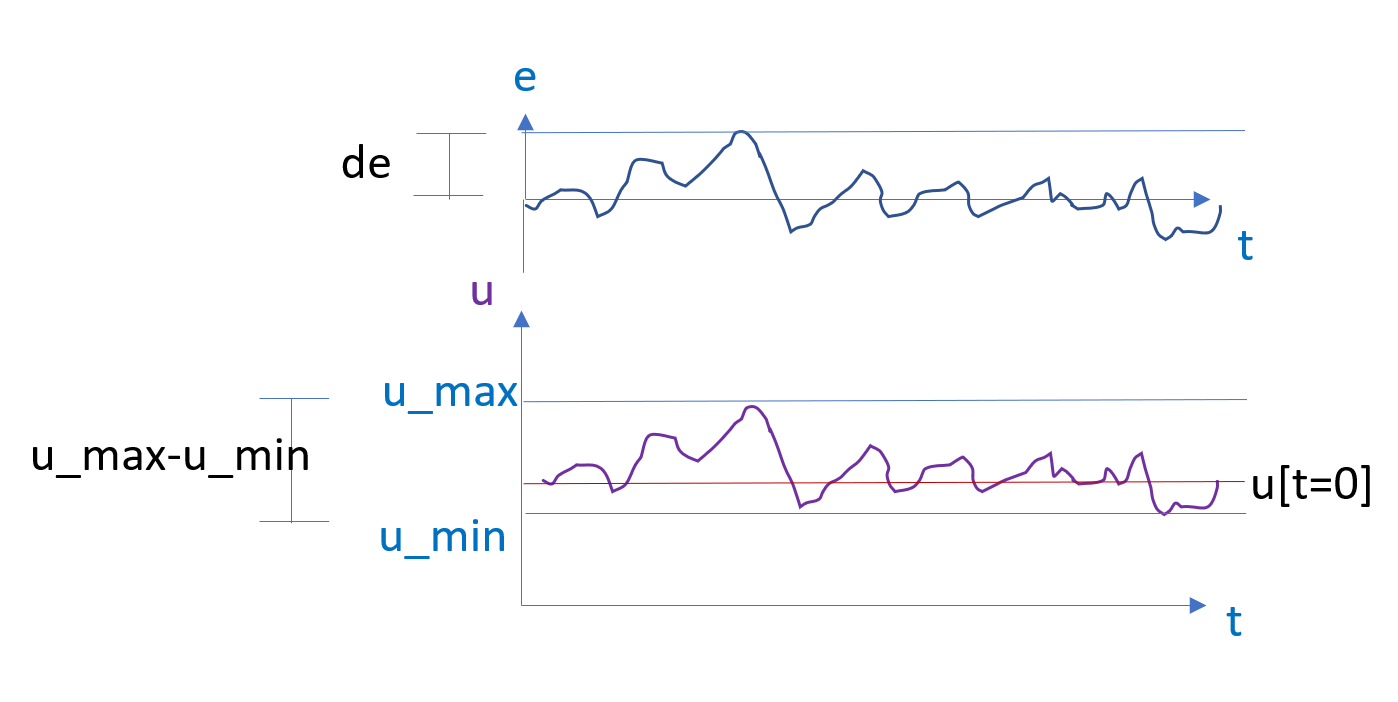
This first estimate of the process gain G_0 in a linear model y = G_0 x u
is found by the approximation
G_0 = max(e)/(max(u)-min(u))
The PID-controller integral effect time constant meant that a peak in the deviation e will not coincide with the peak
in u.
The idea of creating an inital estimate withh min and max values is that it circumvents the lack
of knowledge of the dynamics at this early stage of estimaton.
It has been observed in unit tests that this estimate in some cases is spot on the actual gain, such as when the disturbance is a perfect step.
It seems that the accuracy of this initial estimate may depend on how much the process is close to steady-state for different disturbance values, as disturbance step produces far better gain estiamtes than if the disturbance is a steady sinus(so that the system never reaches steady-state.)
Given the gain an inital UnitModel is created with a rudimentary bias and operating point u0, so that the model can
be simulated to give an inital y_mod(u), so that an estimate d_est(t) can be found.
Because no process dynamics are assumed yet, d_est(t) at this stage will include some transient artifacts if the process
has dynamics. d_est(t) will be attempted improved in subsquent steps.
Guessing the sign of the process gain
Methods for open-loop estimation when applied naively to closed loop time-series often estimate process gain with incorrect sign.
The reason for this is that cause-and-effect relationships are different in closed- and open loop.
It is thus important to use an identification algorithm that is intended
for closed loop signals, and to also include information about the setpoint yset
to the algorithm, so that the algorith can infer about the control error e.
Note
As an example, if inputs u and output y increase in unison,
you would in the open-loop case assume that the process gain is positive.
In the closed-loop case, the same relation between input and output change
is often indicative of a negative process gain.
In the closed loop, a disturbance enteres the output y, is counter-acted
by the controller output u, so an increasing u in response to
an increasing y would be because the sign is negative. The inverse
is also true, what appear to be negative process gains at first sight may in
closed-loop be positive process gains.
The strategy that is employed by the algorithm is to required the PID-parameters to be identfied prior to running the closed-loop identifier, and to use the sign of the Kp in these paramters to set the sign of the process gain.
Step2: Process gain global search (setpoint changes or u_ext changes)
The inital guesss for the process gain and process gain sign above have not considered the pid-controller and its dynamcis, including any setpoint changes that the dataset may contain.
in the case of setpoint changes
If there are setpoint changes, it would be wise to try to use these to improve the model, but broadly speaking there are two kinds of changes that we could envisage:
- setpoint "step" changes due to an operator manually changing a setpoint
- continous smaller setpoint changes due to the controller being the innner loop in a "cascade" where another PID-controller or an MPC acts as the outer loop.
In the second case, the the setpoint changes will be frequent and small, and will probably be correlated with the disturbance, while in the first case, the setpoint change will be independent of the disturbance.
To determine the disturbance in the case of setpoint changes,
The PID-model and process model is simulated in a closed loop with no disturbance acting on it, but where the actual setpoint
signals and any external model inputs u are applied. This results in a simulation of "what the output y_meas would have been
if the disturbance was zero" that can be repeated for different gains of the PID-input u_pid in the process model.
It has been observed that the process gain that results int the smallest
"mean-absolute-diff" of u_pid (referred to as u_pid_adjusted in code)
in this "disturbance free" simulation is a good esimate of the true process gain for datasets
where there are changes in the setpoint, found as_
var uPidVariance = vec.Mean(vec.Abs(vec.Diff(u_pid_adjusted))).Value
The algorithm seems to in general give better estiamtes of the process if there are step changes in the external inputs or in the pid-setpoint, and the algorithm appears to be able to handle both cases.
The above works equally well in the case that process to be simulated is a multiple-input system and the other non-pid inputs are changed during the tuning set.
Finding the gain that gives the disturbance with the shortest travelled distance
If there are no setpoint changes, the above method of determining the process gain will not succede, as the objective function will be flat.
In this case, the global search instead attempts to find the process gain that results in the disturbance that "travels the shortest distance", expressed as:
`` var dEstVariance = vec.Mean(vec.Abs(vec.Diff(dEst))).Value''
Some obervations:
- this method is heurisitic
- the objective usually has a minimum, but not always (such as if the disturbance is a perfect sinus in unit tests)
- the objective space is fairly flat, the minum has a fairly low ``strength'', i.e neighborhing process gains have almost equally low objectives
- the objective space seems to be more concave ("stronger" i.e. more significant minimums) when the process gain is higher.
There are essentially two ways of calculating the disturbance
- By subtracting the modelled
y_{proc}(\hat{u})from\bar{y}'' :d_est = \bar{y} - y_{proc}(\hat{u})`` - By `d_est = d_HF(\hat{u}, y_{set}) +d_LF (u)``
where
d_LF (u) = \hat{y}(u(t))- \hat{y} (u(t_0))
Note that d_HF does not change with changing estimtes of the model gain or other paramters, while d_LF does.
Combining the two above means that
d_LF(u) = (\bar{y} - y_{proc}(\hat{u})) - d_HF(\hat{u}, y_{set})
The smaller the process gain is the more d_est is similar to d_LF.
It is possible to plot the solution space of the d_est for different Kp, and in periods where there is small changes in the integral term of the pid-controller, the disturbance looks quite similar for different Kp. So while in some periods vary with a factor 10 when Kp varies with a factor 10, in other peridos it just varies with a factor 2.
Estimating upper-and lower bounds on the process gain
It may be that the algorithm has a better accuracy when there are setpoint changes in the dataset. It may also be that there the model will do better when there are large "wavy" disturbances than when the disturbances are small and noisy.
An online identification can choose among different datasets to do identification from, and if estimates of the upper- and lower bounds on the gain were available, this knowledge could guide the choice of tuning data set.
Knowing upper- and lower bounds could also be a useful guide for subsequent manual fine-tuning of the process model.
Step3: Determing the dynamic parameters of the process
If the process is actually dynamic yet is modeled as static, then the above methodology will result into un-modeled transients bleeding into the estimated disturbance, where they will appear as "overshoots" 2.order dynamics in the estimated disturbance.
If every change in e is followed by similar transient in d then this is a sure sign that there is un-modeled dynamics,
if these "transients" can be described by adding dynamic terms to models and this causes a "flatter" estimated disturbance,
then this is usually preferable.
These un-modeled transients may also cause process gains and disturbance estimates to be skewed slightly too large.
In the final step, the ClosedLoopUnitIdentifier tries to modify the static models identifier previously by adding larger and larger time constants to the identified model, and observing if this reduces the *absolute, sample-over-sample variance in the disturbance".
Algorithm
parse data and remove bad data points
"init":
- estimate the disturbance (preferably with a pre-specified PidModel)
- estimate the model for the given disturbance (UnitIdentifier.IdentifyLinearAndStatic)
perform in two passes with the bounds on gain narrowing for each pass:
- "step 1":
- global search for linear gain, around the current best estiamte
- "step 2":
- global search for time constant : while loop increase time constant ``T_c'' as long as the deviation of the disturbance decreases.
- "step 1":